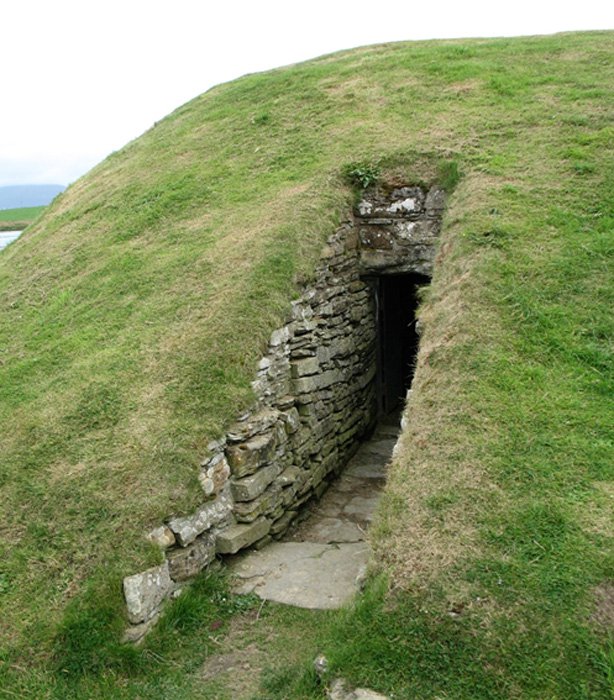 |
For most people, being a part of a close family that loves one another is the key to a happy life. Although some family members can get on each other’s nerves, these people are there at the end of the day.
It is always difficult when one of these family members dies, and often difficult to decide how to prepare the body after death.
Whether a family member decides to be cremated or buried in a coffin, there is importance as to how the deceased family member is finally laid to rest for eternity.
While most cultures bury their dead and visit the gravesite often, Neolithic Britons celebrated their loved ones a bit more violently. These ancient people decided their loved ones needed to be hacked limb from limb before being mixed up in a pit.
Excavations carried out by archaeologists show that the people who had once lived during the Stone Age on the Orkney islands had cut marks and scrapes etched into their bones. The deceased had been chopped up by their family members before their remains had been mixed up into a communal gravesite.
A new forensic study done by the archaeologists suggest that the scrape and chop marks were the result of a deliberate practice known as “de-fleshing activities”.
Experts believe that the ancient people had butchered their family members nearly 6,000 years ago in order to erase their individual identities since the people believed that their dead ancestors were to be thought of as a collective group.
By chopping up the remains of the deceased and mixing them up, it meant that the people had overcome the different states of decay. One person may have died months ago, the other just a day ago – the mix preserved the collective nature of the culture and, additionally, most likely served to curb the stench of the decaying process.
These new studies have been released to the public after Dr. Rebecca Crozier from the University of the Philippines revealed the new information and evidence. She is a specialist in human osteology, forensic archaeology, and mortuary analysis.
The Orkney Islands are believed to be the home of about 72 tombs, known as cairns. Each one dates back to about 4,000 BC. The burial sites have been studied by many experts who have debated for years how the ancient people buried their dead.
Crozier’s study had involved looking into two particular ancient tombs at Quanterness and Quoyness. She had reanalyzed over 12,000 bones that had been excavated previously. These bones, in particular, came from the tombs on the mainland Orkney and Sanday.
Studies done previously by other experts found that the bones of the deceased had been mixed together at two different sites rather than allowed to remain intact skeletons.
On further analysis, the experts found that the bodies had been burned or buried until the skin was fully decomposed. Then, certain bones were moved to a tomb. The same type of bones were found in similar tombs in southern England.
Although a majority of the remains had been prepared this way, Crozier found that some of the deceased had been brought to the tombs with their bodies intact.
In the tombs, their remains were chopped up and then their skin would be scraped from the bone in what she believes is a violent ceremony.
In order to support this theory, she had used a method called the zonation system. This type of method allows archaeologists to use a detailed database from the remains to look at the different marks found on the bones.
At Quanterness, Crozier had believed that some bones were missing from the tombs, however, she found that the bones were still in the tomb but had been broken into smaller pieces. She also found that there were about 40 different individuals who had been the victim of pitting. Pitting had been used when the individuals were hit hard with a blunt tool.
She had shown reporters one bone that showed it had been struck two times with a stone tool. She also pointed out that she discovered 10 bones that had cut marks, 19 that had chop marks, and three that had scrape marks.
She told reporters that these are all pieces of evidence that show these bodies had been dismembered. Her research had shown modification on about 10 percent of the remains at the Quoyness burial site. She claimed that the particular marks found on those bones had been part of the “deliberate dismemberment”.
Because this is all mind-boggling to current cultures, Crozier attempted to explain why these ancient people dismembered their family members in the first place.
She had believed that the people thought their dead ancestors were more of a “collective” rather than individuals.
She added that the dismembering was an attempt to “transform the individual to corporate identity”. The people had broken up the remains and then mixed them together in order to make the people unidentifiable.
So the question is, just why did the people decide to cut up their family members instead of letting the whole body decompose?
Crozier explained that the stages of decay may not have been the same for each individual. The rate of decay could have had a range of issues, for example, the way the individual died or the time of year they died.